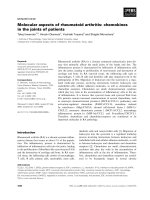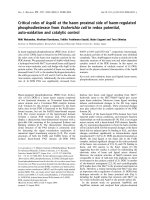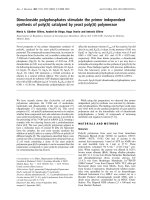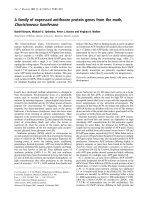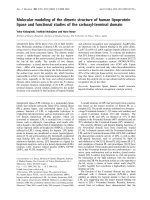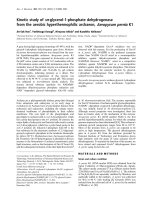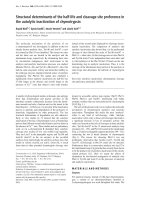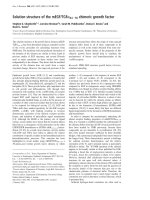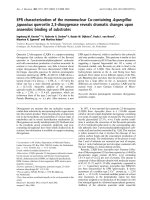Báo cáo y học: "Critical Aspects of the History of Occupational Asthma" pdf
Bạn đang xem bản rút gọn của tài liệu. Xem và tải ngay bản đầy đủ của tài liệu tại đây (89.86 KB, 4 trang )
74
Occupational asthma (OA) is defined as asthma
that is due to causes and conditions attributable to
a particular occupational environment and not to
stimuli encountered outside the workplace.
1
It has
been estimated to account for 10 to 15% of all
adult-onset asthma.
2
It is most often caused by sen-
sitization to a workplace substance (via
immunoglobulin E [IgE] antibody responses or
other immunologic mechanisms) but can also be
due to high-level irritant exposure in about 5% of
all cases (irritant-induced asthma,
3
of which the
clearest example is reactive airways dysfunction
syndrome [RADS]
4
). This article will not discuss
work-aggravated asthma, which is the aggravation
of underlying asthma by factors in the workplace
such as exertion, cold air, dusts, smoke, or fumes.
The best medical outcome for those with OA
related to a sensitizer is associated with removal
from further exposure to the sensitizer, especially
early after the onset of symptoms and when the
asthma is relatively mild.
5
Nevertheless, the diag-
nosis can result in very significant socioeconomic
effects, even with appropriate workers’ compen-
sation support.
6
An accurate and early diagnosis
is therefore of great importance, to allow a better
medical outcome and to facilitate early reloca-
tion within the same company or retraining to
give the worker the best chance for reentry at
another workplace. Unfortunately, there are often
delays in the diagnosis of OA, and the diagnosis
may not be reached until several years after the
onset of symptoms.
7
A recent chart review at an
occupational lung clinic in Ontario showed a mean
time to diagnosis of over 3 years. Delayed suspi-
cion of work-related asthma by the primary care
physician was related to the patient’s fear of los-
ing work and to a lack of inquiry by the physician
about the relationship of the asthma to the patient’s
work.
7
Lower income and education levels were
also associated with a longer time to diagnosis.
Review Article
Critical Aspects of the History
of Occupational Asthma
Susan M. Tarlo, MB, BS, FRCP(C)
Abstract
The medical history is the gateway to the diagnosis of occupational asthma. The medical history should indi-
cate whether a patient’s asthma began during a work period and whether the asthma worsens during work
periods or improves on days when the patient is off work or on holidays. A suspicion of sensitizer-induced
occupational asthma will increase if the patient was exposed to a recognized respiratory sensitizer in the work-
place at the time of the onset of symptoms or if the patient had associated symptoms of allergic rhinitis and
conjunctivitis. A history of accidental high respiratory irritant exposure shortly before the initial onset of symp-
toms would raise the possibility of irritant-induced occupational asthma. Although such features of the history
are sensitive indicators of occupational asthma, they are not specific and should therefore be followed by fur-
ther investigations to confirm the diagnosis of asthma and its relation to the workplace exposure. The earlier
the diagnosis is suspected and investigated, the better the outcome is likely to be for the patient.
S.M. Tarlo—Toronto Western Hospital, Gage
Occupational and Environmental Health Unit, University
of Toronto, Toronto, Ontario
Hospital, EC4-009, 399 Bathurst St., Toronto, ON M5T
2S8; e-mail:
DOI 10.2310/7480.2006.00008
Correspondence to: Dr. Susan M. Tarlo, Toronto Western
Critical Aspects of the History of Occupational Asthma — Tarlo 75
OA will not be suspected without a careful his-
tory. The symptoms of OA are identical to the
symptoms of nonoccupation-related asthma—
episodic wheeze, dry cough, shortness of breath,
and chest tightness—and may occur singly or in
combination. However, the physician should ask
at least the following key questions when assess-
ing any patient with asthma that starts or worsens
during the patient’s working life:
• Was there an unusual workplace exposure
within 24 hours before the onset of initial
asthma symptoms?
• Is there a difference in asthma symptoms dur-
ing weekends or other days away from work?
• Is there any difference in asthma symp-
toms on holidays away from work?
These questions have implications as explained
further.
An unusual exposure at work—a spill or some
other high-level exposure to a potentially irritant
chemical, especially within 24 hours before the
onset of initial asthma symptoms and especially
if symptoms were severe enough to lead the worker
to seek emergency treatment at that time—would
raise the suspicion of irritant-induced asthma or
RADS. RADS is the most definitive form of
irritant-induced asthma and has the following fea-
tures (most of which are based on history, as
described by Brooks and colleagues
8
):
• Onset within 24 hours of a high-level expo-
sure to a respiratory irritant
• Symptoms typical of asthma
• No previous history of lung disease in the
patient
• Symptoms of asthma that persist for at least
3 months after onset
• Pulmonary function findings that show air-
flow limitation with a significant bron-
chodilator response or that show a positive
methacholine or histamine challenge
response
Although these criteria (for RADS) are the
most stringent criteria for irritant-induced asthma,
some reports have described the onset of irritant-
induced asthma at a later point, after a high-level
irritant exposure (up to a week later in some
reports). Some authors have reported this syn-
drome to occur with nonmassive irritant expo-
sures although the certainty of its being caused by
the patient’s work becomes less as the criteria
become less stringent. A positive response to the
above-mentioned screening question should there-
fore be followed by further questioning to deter-
mine the conditions of exposure, the time of the
onset of asthma symptoms after the exposure, the
duration of the symptoms, and a history of likely
previous lung disease or previous allergic symp-
toms. The potential diagnosis is then further inves-
tigated by objectively confirming a diagnosis of
asthma; objectively assessing the accidental expo-
sure conditions when possible; and by reviewing
previous medical records to exclude prior lung dis-
ease when possible.
Two of the key questions listed above—Are
asthma symptoms better on weekends away from
work, and are asthma symptoms better on holi-
days?—are not specific to work-related asthma
(patients with asthma can feel better when relax-
ing on a beach or elsewhere on weekends or on
holidays, compared with when they are working).
Nevertheless, a response that indicates improve-
ment when away from work is a sensitive indi-
cator for OA related to a work sensitizer and
also for work-aggravated asthma. Among patients
who were being objectively assessed for OA in
a study from Québec, 88% of those who were
objectively confirmed to have OA gave a posi-
tive response to the question about improvement
in symptoms on holiday, as opposed to 76% of
those who did not have OA (but who still may
have had work-aggravated asthma).
9
Therefore,
although the question appears to be a sensitive
one, further information is needed for a diagno-
sis of OA.
Similar responses to this question were iden-
tified among Ontario Workers’ Compensation
claimants.
10
Among those whose claims of OA
were accepted, 70% reported improvement during
weekends off work and 88% reported improvement
when on holidays, as opposed to 41% and 54%,
respectively, of those who were deemed to have
asthma unrelated to work. Thus, a relatively high
76 Allergy, Asthma, and Clinical Immunology / Volume 2, Number 2, Summer 2006
percentage of those with a final medical diagno-
sis or compensation decision of unrelated asthma
had a positive history even though it may have been
expected that such a history might have increased
the likelihood of a positive compensation decision.
In a more recent study from Belgium and
Québec, Vandenplas and colleagues found that
(1) wheezing reported from history to be related
to work was the most specific symptom for OA,
occurring in 88% of those with OA; (2) an asso-
ciated history of work-related eye and nasal symp-
toms had a relatively good predictive value for OA;
and (3) additional associated itching of the nose
and eyes in OA was related to high-molecular-
weight sensitizers.
11
In contrast, loss of the voice,
as part of the work-attributed symptoms, was neg-
atively associated with OA. Vandenplas and col-
leagues reported a 74% correct prediction of the
diagnosis in the study when using a predictive
model from patient history as opposed to specific
challenge tests (their “gold standard”).
A detailed occupational history can also help
to better assess likely exposure to a known work-
place respiratory sensitizer. It should focus par-
ticularly on exposures at the time the asthma
started or worsened at work. Workers whose occu-
pations are commonly associated with sensitizer-
induced OA include the following:
• Workers exposed to diisocyanates (eg, while
making polyurethane foam, using spray
paints, or using these compounds in moulds
in foundries or in the manufacture of par-
ticleboard)
• Workers exposed to animals (eg, veterinar-
ians, farmers, animal laboratory workers)
• Bakers, workers exposed to grain (farm-
ers, grain handlers), and workers exposed
to airborne food proteins
• Workers exposed to wood dusts (eg, car-
penters, construction workers)
• Metal workers exposed to complex plat-
inum salts, soldering flux, or metal salts
Commonly reported causes of irritant-induced
OA include accidental spills or other high-level
exposures to diisocyanates, acids, chlorine or
chlorones, irritant alkaline dusts, and smoke.
The patient’s job title may not give a clear
indication of his or her exposure, and the patient also
may be exposed to dusts or fumes from products
used by nearby workers. Therefore, it is important
to question the patient about his or her job descrip-
tion and that of others in the same work environ-
ment. However, the patient may not know what he
or she is exposed to at work, and it can be very help-
ful to ask the patient to obtain copies of Material
Safety Data Sheets (MSDSs) from the workplace
for review. Workers are entitled to receive copies
of these sheets, which list the known hazardous
ingredients in products used at the workplace. In
Canada, if a recognized respiratory sensitizer con-
stitutes ≥ 0.1% of a chemical product, it must be
listed as a hazardous ingredient (the US requirement
is ≥ 1%). Providing the patient with a note asking
the patient’s supervisor or workplace Health and
Safety Committee to provide MSDSs for products
used by the patient and by co-workers in the area
can assist in obtaining these. However, MSDSs
are designed to list toxic effects rather than hyper-
sensitivity responses and may not list “natural prod-
ucts” that contain potentially sensitizing proteins,
so it may be necessary to request additional infor-
mation from the product manufacturer or from the
workplace (with the patient’s permission). In addi-
tion, there are over 250 reported workplace sensi-
tizers, and OA can occur in multiple workplace
settings. (Many of these sensitizers are listed on-line
at <www.asmanet.com>.) However, the absence of
an identified exposure to a sensitizer does not
exclude OA.
There are other aspects of the history that are
very useful. Patients with OA from exposure to
high-molecular-weight sensitizers that induce OA
through an IgE-antibody–mediated mechanism
commonly have associated symptoms of allergic
rhinitis and conjunctivitis when exposed to the sen-
sitizer at work.
12
These symptoms may start prior
to or concurrently with the onset of asthma.
13
The initial onset of asthma symptoms that are
related to a sensitizer (an actual or presumed
immune response) occurs after a latent period of
exposure, which can range from weeks to years.
This is in contrast to the onset of irritant-induced
asthma, which most typically begins within 24
hours after a very high irritant exposure. Once sen-
Critical Aspects of the History of Occupational Asthma — Tarlo 77
sitizer-induced OA is present, asthma symptoms
related to work exposures can range from imme-
diate responses (ie, within minutes after further
exposure to the sensitizer) to late responses (typ-
ically 4–6 hours after exposure, more commonly
as an isolated response when the sensitizer is a low-
molecular-weight agent) or can be a dual asthmatic
response (an immediate response followed by a late
response). The association with work may be less
obvious to the patient if an isolated late response
occurs, because the worsening of symptoms may
begin or progress after the work shift. In addition,
improvement away from work may not be evident
for a few days away from exposure and therefore
may be noted only at the end of a weekend away
from work or during a holiday period.
Improvement away from work has been con-
sidered a sensitive marker of OA from history, but
studies of workers with OA who have been removed
from further exposure at work have identified a sub-
group of workers whose asthma does not improve
or whose asthma even worsens by the time of
follow-up assessment. Lack of improvement has
been seen more commonly when there has been a
longer period before diagnosis and more severe
asthma at the time of diagnosis, emphasizing the
need for physicians to think of OA and to ask asth-
matic patients early on about a work relationship.
Although the history is clearly an essential part
of making the diagnosis, the incorrect prediction
in 26% from history alone in the recent study
11
emphasizes the need for further assessment of
those with a positive response (as detailed in
recent guidelines and reviews
14,15
), to avoid unnec-
essary job loss. The history is critical to the diag-
nosis of OA; without an appropriate history, the
patient is unlikely to undergo the objective tests
needed to make the diagnosis
14,15
and allow appro-
priate workplace environmental changes.
References
1. Bernstein IL BD, Chan-Yeung M, Malo J-L.
Asthma in the workplace. 2nd ed. New York:
Marcel Dekker, Inc; 1999.
2. Balmes J, Becklake M, Blanc P, et al. American
Thoracic Society statement: occupational con-
tribution to the burden of airway disease. Am J
Respir Crit Care Med 2003;167:787–97.
3. Tarlo SM, Broder I. Irritant-induced occupational
asthma. Chest 1989;96:297–300.
4. Alberts WM, Brooks SM. Reactive airways dys-
function syndrome. Curr Opin Pulm Med
1996;2:104–10.
5. Paggiaro PL, Vagaggini B, Bacci E, et al.
Prognosis of occupational asthma. Eur Respir J
1994;7:761–7.
6. Vandenplas O, Toren K, Blanc PD. Health and
socioeconomic impact of work-related asthma.
Eur Respir J 2003;22:689–97.
7. Poonai N, van Diepen S, Bharatha A, et al.
Barriers to diagnosis of occupational asthma in
Ontario. Can J Public Health 2005;96:230–3.
8. Brooks SM, Weiss MA, Bernstein IL. Reactive
airways dysfunction syndrome (RADS).
Persistent asthma syndrome after high level irri-
tant exposures. Chest 1985;88:376–84.
9. Malo JL, Ghezzo H, L’Archeveque J, et al. Is the
clinical history a satisfactory means of diagnos-
ing occupational asthma? Am Rev Respir Dis
1991;143:528–32.
10. Tarlo SM, Liss G, Corey P, et al. A workers’ com-
pensation claim population for occupational
asthma. Comparison of subgroups. Chest
1995;107:634–41.
11. Vandenplas O, Ghezzo H, Munoz X, et al. What
are the questionnaire items most useful in iden-
tifying subjects with occupational asthma? Eur
Respir J 2005;26:1056–63.
12. Gautrin D, Ghezzo H, Infante-Rivard C, et al.
Natural history of sensitization, symptoms and
occupational diseases in apprentices exposed to
laboratory animals. Eur Respir J 2001;17:904–8.
13. Karjalainen A, Martikainen R, Klaukka T, et al.
Risk of asthma among Finnish patients with occu-
pational rhinitis. Chest 2003;123:283–8.
14. Tarlo SM, Liss GM. Occupational asthma: an
approach to diagnosis and management. CMAJ
2003;168:867–71.
15. Tarlo SM, Boulet LP, Cartier A, et al. Canadian
Thoracic Society guidelines for occupational
asthma. Can Respir J 1998;5:289–300.
